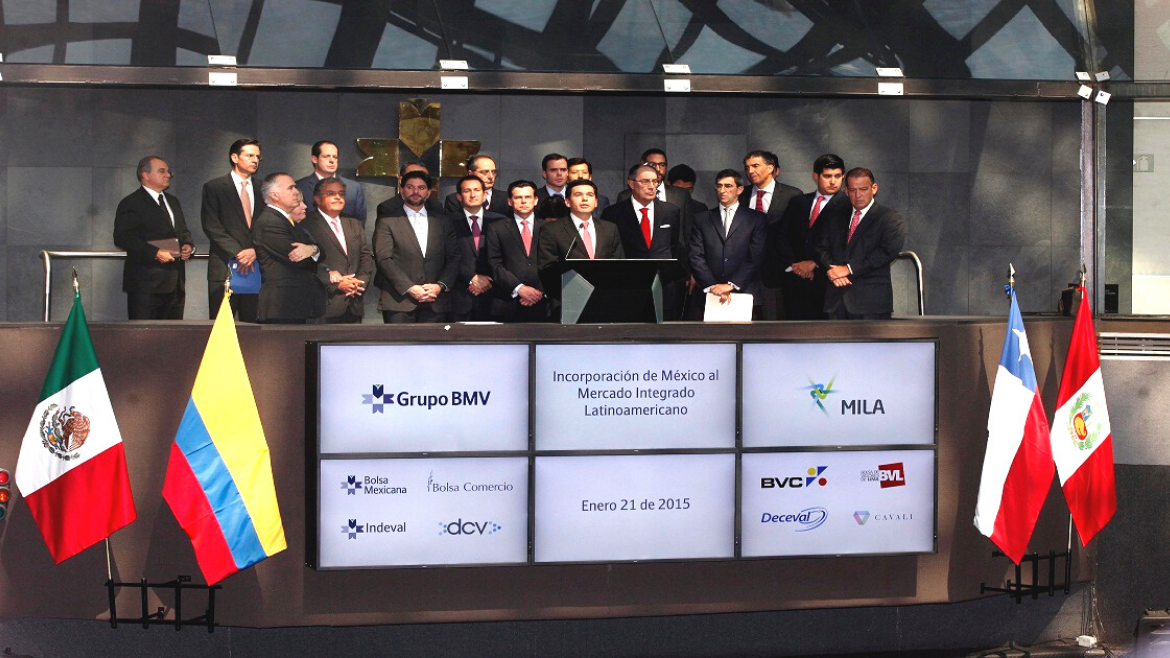Backgrounder Content
- What is the origin and process of the “integration”?
- What is the scope of the MILA?
- What are the benefits and challenges for public companies and investors?
- Are there online discount brokers associated with MILA? How can foreigners participate?
- What has been the success thus far, and what other nations will join?
.
What is the origin and process of the “integration”?
In 2009, the stock exchanges and clearing houses of Chile, Colombia, and Peru decided to create a common exchange, the Latin American Integrated Market (MILA). It began operating in 2011, and Mexico effectively joined in 2014, turning MILA into the largest stock exchange in Latin America at the time by market capitalization, surpassing Brazil’s B3 stock exchange.
MILA facilitates the issuance, trade, and settlement of securities across member countries. However, it is not a full integration of capital markets; the different currencies, tax regimes, commissions, and investment rules of each country still apply. Further, all markets maintain their own domestic clearing houses.
There is an ongoing process toward comprehensive harmonization through the Pacific Alliance, a free-trade bloc started by the same countries in 2011. The Pacific Alliance strives to become a pro-market version of Mercosur, but there is still a long way to go that requires coordinated legislative action.
An executive committee composed of the heads of each stock exchange and clearing house runs MILA.
.
What is the scope of the MILA?
Stocks, funds quotas, ETFs, and other non-fixed-income securities from over 600 issuers can be traded on MILA.
All trades are done in the local currency of the country where the security was issued: Mexican pesos, Chilean pesos, Colombian pesos, or Peruvian soles.
There are also mutual funds available in Chile (SURA, SCOTIA, and ITAÚ), Peru (BBVA and BCP), and Mexico (MILATRC) that invest exclusively in MILA assets. Colombia has no such funds. The largest fund holds a little over US$10 million and is managed by the bank Itaú in Chile.
There are six indices that track MILA assets in US dollars and four in local currencies:
- S&P MILA Pacific Alliance Select (USD)
- DJSI MILA Pacific Alliance (USD)
- S&P MILA Pacific Alliance Composite (USD)
- S&P MILA Pacific Alliance Financials (USD)
- S&P MILA Pacific Alliance Industrials (USD)
- Chile, Colombia, and Peru: S&P MILA Andean 40 (USD)
- Chile’s stock exchange: S&P IPSA
- Colombia’s stock exchange: COLCAP
- Mexico’s stock exchange: S&P/BMV
- Peru’s stock exchange: S&P/BVL
.
What are the benefits and challenges for public companies and investors?
Participants benefit mainly from more opportunities for diversification. By listing securities on one of the MILA exchanges, firms gain access to the other exchanges, expanding the possibilities of raising capital. In turn, investors have access to a larger pool of companies in many sectors and countries, lowering political and economic risks.
Since every transaction is denominated in the currency of the country where the security was issued, investors must convert funds prior to making a trade. This can expose investors to foreign-exchange risk for each currency pair (that of the investor and that of the security).
The applicable taxes for dividends, capital gains, and trading of certain securities depend both on the country where the security was issued and the nationality of the buyer, turning it into a complex maze to navigate.
.
Are there online discount brokers associated with MILA? How can foreigners participate?
No. Only authorized brokers based in a member country are allowed to trade through MILA on behalf of clients. Brokers can choose to operate in one or more MILA markets and set their own commissions and fees.
To have access to MILA, investors must become a client of a registered broker in any of the member countries. Requirements in each jurisdiction vary, but there is no formal impediment to non-MILA foreign investors trading securities. The applicable regulations, taxes, and procedures will be those of the nation where the investor has decided to open a brokerage account.
- Chile has nine brokers able to operate in Colombia, two in Mexico, and nine in Peru.
- Colombia has nine brokers able to operate in Chile, three in Mexico, and 10 in Peru.
- Peru has eight brokers able to operate in Chile, eight in Colombia, and two in Mexico.
- Mexico has two brokers able to operate in Chile, Colombia, and Peru.
.
What has been the success thus far, and what other nations will join?
The number of registered issuers and the total market cap has decreased in recent years. In April 2018 there were 655 issuers with a total market cap of $991.4 billion. In June 2020, the latest month for which data is available, there were 624 issuers with a total market cap of $627.6 billion, dipping below Brazil’s B3 stock-exchange capitalization of $731 billion.
Since its inception, 29,900 trades have been conducted through MILA, totalling a volume of $626.6 million. Peru’s brokers have traded 70.5 percent of that value, followed by Chile’s (17.4 percent), Mexico’s (10.2 percent), and Colombia’s (1.75 percent).
According to Julián Andrés Galvis Polo, a Colombian financial analyst and university professor, MILA is still not mature enough. He notes there are few tax incentives to trade through it and a lot of red tape. For example, Colombia’s foreign-currency controls and tax disincentives to invest abroad hinder participation in MILA.
The institution’s website is outdated and lists no major changes since 2014, when Mexico, the last country, joined MILA.
Previous Coverage
“Chile Aims to Become Regional Financial Hub,” by Paz Gómez.




